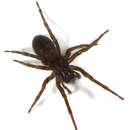en
names in breadcrumbs


As treated by Platnick (2013), the spider family Gnaphosidae includes 2147 recognized species, making it one of only seven spider families (out of 112 total) with over 2000 species; nearly 5% of the spider species recognized by Platnick are gnaphosids. According to Ubick (2005), 255 gnaphosid species occur in North America north of Mexico and, although most are in widely distributed genera, most of the species diversity within these genera is concentrated in the western and southwestern portion of this region.
Gnaphosids are primarily ground dwellers and wandering hunters. They are mainly nocturnal or crepuscular (i.e., active at dawn and dusk) and are found in leaf litter, beneath rocks, and within and under decomposing wood. Some synanthropic species occur in and around buildings (e.g., in North America, the native Parson Spider [Herpyllus ecclesiasticus] and the introduced European Mouse Spider [Scotophaeus blackwalli] and Eurasian Urozelotes rusticus) (Ubick 2005; Bradley 2013).
Gnaphosids do not build webs. They use silk only for draglines, retreats, and egg sacs. The egg sacs may be constructed within a retreat and guarded by the female or secured to the substrate and either guarded or abandoned. The egg sacs of at least some species are flat with a swollen center and made of a parchment-like silk. Gnaphosids are mostly generalized predators, feeding on a wide range of prey, including other spiders and ants (Ubick 2005; Bradley 2013).Micaria species are ant mimics and, unlike most gnaphosids, are diurnally active, associated with various ant species, and often found in the same sunny habitats where ants are common (Platnick and Shadab 1988; Bradley 2013). (Ubick 2005 and references therein).
The anterior spinnerets of gnaphosids are cylindrical and widely separated and often extend conspicuously beyond the end of the abdomen. Like most spiders, gnaphosids have eight eyes, but their posterior median eyes are often unusually bright. These eyes have an unusual flattened surface and are oval in shape. (Bradley 2013)The normal dome-shaped focusing lens in these modified eyes has been lost and the flattened, irregularly shaped eye surface is frequently ridged. It seems clear that these highly modified posterior median eyes do not function in normal vision, i.e., do not focus an image. Instead, they appear to be specialized for detecting light polarization. (Platnick 2002) Mueller and Labhart (2010) investigated the mechanism of polarization vision in the gnaphosid Drassodes cupreus. Spiders of this species have been shown to use polarization cues to find their way back to the nest after foraging trips (Dacke et al. 1999; Dacke et al. 2001 reviewed detection of polarized light by spiders more broadly).
Platnick (2013) recognizes 121 gnaphosid genera. According to Ubick (2005), 24 of these occur in North America north of Mexico and Ubick provides the following summary of the broader geographic distribution of these North American genera (genera now present in, but not native to, North America are marked with an asterisk):
Worldwide: Drassodes, Micaria, *Urozelotes, Zelotes
Holarctic: Callilepis, Gnaphosa, Haplodrassus, Parasyrisca, Talanites
Nearctic: Herpyllus, Orodrassus, Scopoides, Sosticus
North America: Cesonia, Litopyllus, Nodocion, Sergiolus
Nearctic and Neotropical: Drassyllus
Neotropical: Gertschosa
Neotropical and African: Camillina
Gondwanan to South Nearctic: Eilica
Palearctic: *Scotophaeus, *Synaphosus, *Trachyzelotes
Ground spiders comprise Gnaphosidae, the seventh largest spider family with over 2,000 described species in over 100 genera distributed worldwide. There are 105 species known to central Europe,[1] and common genera include Gnaphosa, Drassodes, Micaria, Cesonia, Zelotes and many others. They are closely related to Clubionidae.[2] At present, no ground spiders are known to be seriously venomous to humans.
Generally, ground spiders are characterized by having barrel-shaped anterior spinnerets that are one spinneret diameter apart. The main exception to this rule is found in the ant-mimicking genus Micaria. Another characteristic is an indentation in the endites (paired mouthparts anterior and lateral to the labium, or lip). All ground spiders lack a prey-capture web and generally run prey down on the surface. They hunt at night and spend the day in a silken retreat.[2] The genitalia are diverse and are a good model for studying the evolution of genitalia because of their peculiar copulatory mechanism.[3] The thick-walled egg sacs are guarded by the mother until the spiderlings hatch.[2]
Ground spiders hunt by active foraging, chasing down and subduing individual prey items. They are adapted to hunting large and potentially dangerous prey, including other spiders, which they subdue by using their silk. When hunting, ground spiders produce thick, gluey silk from their enlarged spinnerets and attempt to use it to entangle their prey in swathing attacks, often applying their webbing to their prey's legs and mouths. By immobilizing potential prey in this manner, ground spiders can subdue proportionally large creatures while reducing risk of injury to themselves from their prey's attempts to fight back.[4]
As of August 2022, the World Spider Catalog accepts the following genera:[5]
{{cite journal}}: Cite journal requires |journal= (help) {{cite web}}: CS1 maint: url-status (link) Ground spiders comprise Gnaphosidae, the seventh largest spider family with over 2,000 described species in over 100 genera distributed worldwide. There are 105 species known to central Europe, and common genera include Gnaphosa, Drassodes, Micaria, Cesonia, Zelotes and many others. They are closely related to Clubionidae. At present, no ground spiders are known to be seriously venomous to humans.